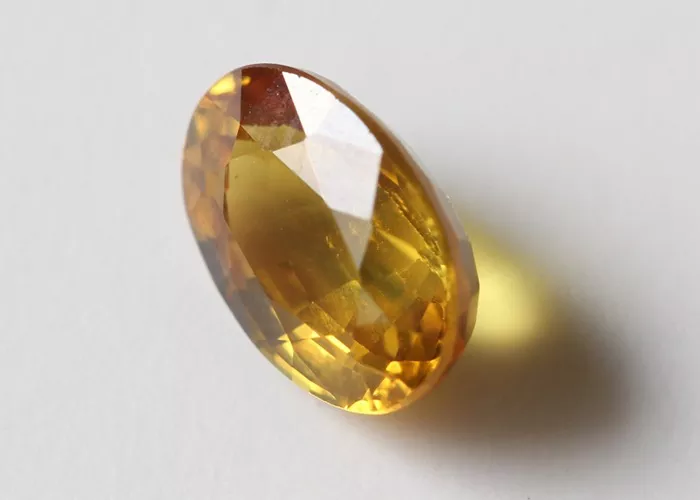Gemstones have been prized for their beauty and rarity for thousands of years. Among the most highly valued gemstones are yellow and blue gemstones, which are known for their vibrant colors and exquisite beauty. In this article, we will explore why real yellow and blue gemstones are so precious, from a professional perspective.
The history of yellow blue gemstones
Yellow sapphire is a very ancient gemstone with a history dating back thousands of years. Here are some important events about the history of yellow blue gemstones:
Ancient India: Yellow blue gemstones were widely used in ancient India and are considered one of the most sacred gemstones. The rulers and spiritual leaders of India like to wear turquoise because it is believed to have the power of protection and healing.
Ancient Greece and Rome: During the ancient Greek and Roman period, yellow and blue gemstones were used as talismans and healing tools. People believe that this gemstone can help alleviate anxiety and enhance intelligence.
Medieval Europe: In medieval Europe, yellow and blue gemstones were considered symbols of heaven and were used in churches and religious art. People believe that wearing yellow blue gemstones can bring sacred protection and blessings.
Modern Era: In modern times, yellow blue gemstones are still a popular gemstone used in jewelry and decorations. It is also widely used in astrology and gemstone therapy, and people believe it can bring good luck and health.
Properties of Yellow and Blue Gemstones
Yellow and blue gemstones are highly valued for their unique properties, which include their color, clarity, and durability. Yellow gemstones, such as yellow sapphires and yellow diamonds, get their color from trace amounts of nitrogen in the crystal structure. Blue gemstones, such as blue sapphires and blue diamonds, get their color from trace amounts of boron in the crystal structure.
In addition to their color, yellow and blue gemstones are prized for their clarity, which refers to the absence of inclusions or flaws in the gemstone. Gemstones with high clarity are more valuable than those with inclusions or flaws.
Finally, yellow and blue gemstones are highly durable, with a rating of 9 on the Mohs scale of hardness. This means that they are resistant to scratches and chips, making them ideal for use in jewelry.
Cultural Significance of Yellow and Blue Gemstones
Yellow and blue gemstones have been prized for their beauty and symbolism throughout history. In ancient India, yellow sapphires were known as “Pukhraj” and were believed to bring wisdom, prosperity, and good fortune to the wearer. In ancient Greece, blue sapphires were associated with the god Apollo and were believed to bring protection and healing.
In modern times, yellow and blue gemstones continue to be highly valued for their symbolism. Yellow gemstones are associated with wisdom, prosperity, and good fortune, while blue gemstones are associated with protection, healing, and spirituality.
Value of Yellow and Blue Gemstones
The value of yellow and blue gemstones is determined by a variety of factors, including their color, clarity, and rarity. Gemstones with a pure, intense color are more valuable than those with a less vibrant color. In addition, gemstones with high clarity and few inclusions are more valuable than those with inclusions or flaws.
The rarity of a gemstone also plays a significant role in its value. Gemstones that are rare or difficult to find are more valuable than those that are readily available. For example, yellow diamonds are among the rarest and most valuable gemstones in the world, due to their scarcity and unique color.
Finally, the cut and size of a gemstone also impact its value. Gemstones that are well-cut and have a large carat weight are more valuable than those that are poorly cut or have a small carat weight.
What is the difference between blue topaz and ordinary sapphire
Sapphires and yellow sapphires are two completely different gemstones that differ in appearance, chemical composition, and price. Here are the main differences between them:
Appearance: Sapphires usually appear dark blue or blue-green, while yellow sapphires appear bright yellow or orange-yellow, sometimes with a green or pink tinge. Yellow sapphires are usually more vivid and bright in color than sapphires.
Chemical composition: The chemical composition of sapphire is aluminum oxide, and its color comes from trace amounts of chromium, iron and titanium. The chemical composition of yellow sapphire is aluminum beryllium silicate, and its color comes from trace amounts of iron and titanium.
Price: Sapphire is a very expensive gemstone, and the price is usually much higher than yellow sapphire. This is because the supply of sapphire is very limited, and its color and transparency have a big impact on the price. The price of yellow sapphire is relatively low because it is in more abundant supply.
In short, sapphire and yellow sapphire are two different gemstones, they are different in appearance, chemical composition and price. If you are considering buying one of these gems, it is recommended that you first learn about their features and prices in order to make an informed decision.
Conclusion
In conclusion, yellow and blue gemstones are highly valued for their unique properties, cultural significance, and rarity. Gemstones with a pure, intense color, high clarity, and few inclusions are the most valuable, as are those that are rare or difficult to find. When purchasing yellow or blue gemstones, it is important to choose a reputable jeweler who can provide a quality gemstone and certificate of authenticity.
Related topic:
- Can Blue Sapphire Improve Capricorn’s Career Prospects?
- How Do the Colors of Montana Sapphires Vary by Locality?
- Where Can You Find Authentic Blue Montana Sapphires?


